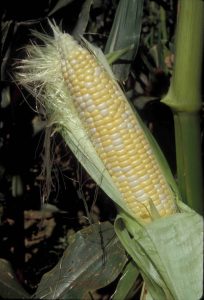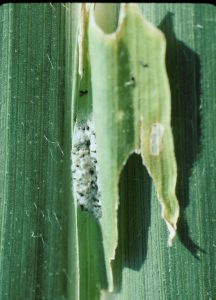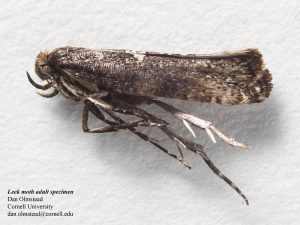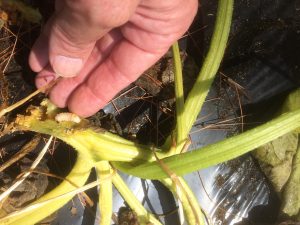Sweet Corn IPM Newsletter No. 6 – July 31, 2017
 University of Maine Sweet Corn IPM Newsletter No. 6 – July 31, 2017
University of Maine Sweet Corn IPM Newsletter No. 6 – July 31, 2017
Click on photos to enlarge.
FALL ARMYWORM PRESSURE INCREASES
New Pest of Onions, Garlic and Leeks Found in Western Maine
SITUATION
Many parts of the state are experiencing very dry conditions, but corn that can be irrigated is progressing well. Corn earworm populations remain very moderate at most sites, and European corn borer numbers are also low in most fields. Fall armyworm numbers continue to rise in most fields, however. A new pest of onions, garlic and leeks has recently been found in Maine. Leek moth may become a problem for crops in the allium group.
European corn borer: Moth captures continue to be low in nearly all locations this week. Larval feeding activity also remained under threshold. We typically see a drop in corn borer activity in the mid-summer, as the larvae from the first generation begin to pupate. However, this may lead to a second generation late in the summer, especially in southern Maine.
Corn earworm: Moth counts remain moderate in most locations this week, with less than half of the trapping sites exceeding a spray threshold. This is less pressure than we typically see at this point in the season. A 6-day spray interval for corn earworm was recommended for silking fields in Levant, Nobleboro, Wales and one Wells site this week. A 5-day spray interval was recommended for silking fields in Garland and Poland Spring. A 4-day spray interval was recommended in Auburn and Lewiston.

Fall armyworm: Moth counts have risen at nearly all trap locations this week, indicating that this pest is presently the most significant threat to corn for most growers. When more than three moths are caught in a week in silking corn, a spray is recommended to prevent larvae from infesting the ears, unless the field is under a spray interval for corn earworm. Sprays for fall armyworm on silking corn were recommended in Biddeford, Cape Elizabeth, Dayton, Farmington, New Gloucester, North Berwick, Oxford, Wayne and one Wells site this week. Auburn, Lewiston, Nobleboro and Wales were also over the 3-moth threshold, but are under a spray schedule for corn earworm.
Leek Moth is a “new” pest of allium crops, including onions, garlic, shallots and leeks. Native to Europe, it was first found in New York in 2009, and has been spreading throughout the northeast. The adult moth is ½-inch long, speckled brown with a white spot on the wings. It is active at night, so is not commonly seen. They lay eggs on the undersides of allium leaves. The larvae are small (3/8-inch) creamy yellow caterpillars that feed on the leaves, leaving translucent channels between the leaf veins. The feeding weakens the plants and allows rot organisms to move in, which can affect the quality and storage life of the bulbs. Leek moths have been caught in pheromone traps in western Maine. We do not yet have any reports of crop damage, but we recommend that you scout your allium crops and let us know if you see any suspected injury. An excellent website has been set up for leek moth by Cornell University.
- Leek Moth Adult; photo by Dan Olmstead, Cornell University
- Squash Vine Borer Larva; photo by David Handley
Squash vine borer moths were above the spray threshold in Biddeford, Cape Elizabeth, and Oxford this week.
Sincerely,
David T. Handley
Vegetable and Small Fruit Specialist
Highmoor Farm, P.O. Box 179, 52 US Route 202, Monmouth, ME 04259, 207.933.2100
UMaine Extension Diagnostic Research Lab, Pest Management Unit, 17 Godfrey Drive, Orono, ME 04473, 1.800.287.0279
| Location | CEW Moths |
ECB Moths |
FAW Moths |
%Feeding Damage |
Recommendations / Comments |
|---|---|---|---|---|---|
| Auburn | 8 | 1 | 7 | 1% | 4-day spray interval recommended on all silking corn |
| Biddeford | 1 | 2 | 51 | 4% | One spray recommended for FAW on all silking corn |
| Bowdoinham | 0 | 0 | 0 | 6% | No spray recommended |
| Cape Elizabeth I | 1 | 0 | 29 | 2% | One spray recommended for FAW on all silking corn |
| Cape Elizabeth II | 0 | 41 | One spray recommended for FAW on all silking corn | ||
| Charleston | 0 | 0 | 2 | 0% | No spray recommended |
| Dayton I | 0 | 0 | 9 | One spray recommended for FAW on all silking corn | |
| Dayton II | 7 | 0 | 39 | 4% | 5-day spray interval recommended on all silking corn |
| Farmington | 1 | 2 | 3 | 1% | One spray recommended for FAW on all silking corn |
| Garland | 4 | 0 | 0 | 2% | 5-day spray interval recommended on all silking corn |
| Lewiston | 11 | 0 | 31 | 1% | 4-day spray interval recommended on all silking corn |
| Levant | 2 | 2 | 0 | 1% | 6-day spray interval recommended on all silking corn |
| New Gloucester | 1 | 0 | 106 | 5% | One spray recommended for FAW on all silking corn |
| Nobleboro | 2 | 0 | 13 | 6-day spray interval recommended on all silking corn | |
| North Berwick | 1 | 1 | 9 | 5% | One spray recommended for FAW on all silking corn |
| Oxford | 1 | 0 | 15 | 0% | One spray recommended for FAW on all silking corn |
| Palmyra | 1 | 5 | 0 | 0% | No spray recommended (no silking corn) |
| Poland Spring | 4 | 0 | 1 | 5-day spray interval recommended on all silking corn | |
| Wales | 3 | 3 | 4 | 0% | 6-day spray interval recommended on all silking corn |
| Wayne | 1 | 0 | 3 | 4% | One spray recommended for FAW on all silking corn |
| Wells I | 0 | 0 | 11 | 0% | One spray recommended for FAW on all silking corn |
| Wells II | 0 | 0 | 9 | 2% | One spray recommended for FAW on all silking corn |
CEW: Corn earworm (Only fresh silking corn should be sprayed for this insect.)
ECB: European corn borer
FAW: Fall armyworm
| Moths caught per week | Moths caught per night | Spray interval |
|---|---|---|
| 0.0 to 1.4 | 0.0 to 0.2 | No spray |
| 1.5 to 3.5 | 0.3 to 0.5 | Spray every 6 days |
| 3.6 to 7.0 | 0.6 to 1.0 | Spray every 5 days |
| 7.1 to 91 | 1.1 to 13.0 | Spray every 4 days |
| More than 91 | More than 13 | Spray every 3 days |
Thresholds apply only to corn with exposed fresh silk. Lengthen spray intervals by one day if maximum daily temperature is less than 80°F.
European Corn Borer Thresholds
Whorl stage: 30% or more of plants scouted show injury.
Pre-tassel-silk: 15% or more of plants scouted show injury.
Silk: 5 or more moths caught in pheromone traps in one week.
IPM Web Pages:
UMaine Cooperative Extension Integrated Pest Management
Penn State Pest Watch for Sweet Corn
UMass Amherst Integrated Pest Management
Where brand names or company names are used, it is for the reader’s information. No endorsement is implied nor is any discrimination intended against other products with similar ingredients. Always consult product labels for rates, application instructions and safety precautions. Users of these products assume all associated risks.
The University of Maine is an equal opportunity/affirmative action institution.


